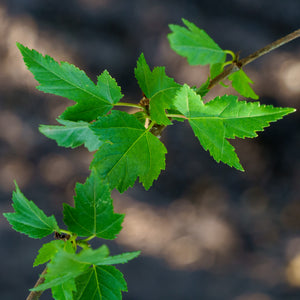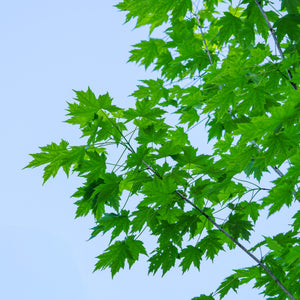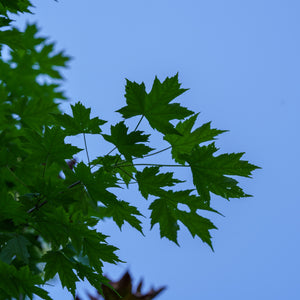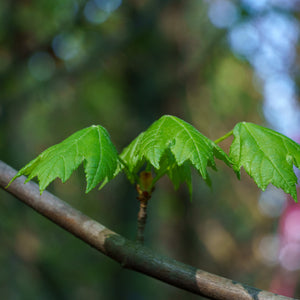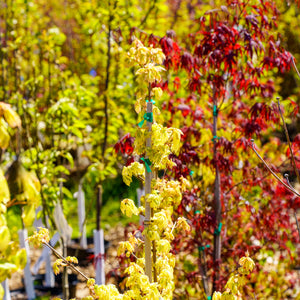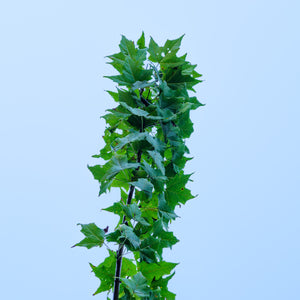The Maple Guide
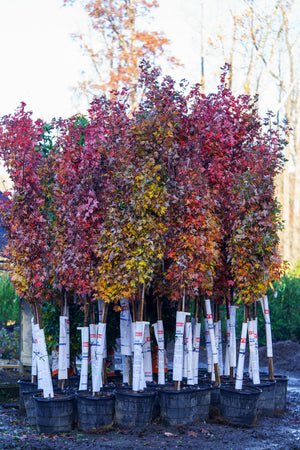
About
The Acer genus includes over 130 species and hundreds of cultivars, native to North America, Europe, and Asia. They range in size from small, slow-growing shrubs to majestic canopy trees. One of the key distinguishing features of maples is their lobed, palmate leaves, which often turn vibrant shades of red, orange, or yellow in autumn.
Acer rubrum (red maple) is one of the most widely planted native species in the eastern United States. Cultivars like ‘Brandywine’, ‘Sun Valley’, and ‘Frank Jr.’ are valued for their strong fall color and adaptability to a range of soils.
Acer saccharum (sugar maple), native to northeastern North America, is celebrated for its brilliant fall foliage and syrup-producing sap. Cultivars such as ‘Green Mountain’, ‘Legacy’, ‘Barrett Cole’, and ‘Commemoration’ offer improved form, disease resistance, and vigor.
Acer x freemanii is a hybrid between red maple and silver maple, combining the best traits of both: rapid growth, strong branching, and vivid red foliage. Popular selections include ‘Autumn Blaze’, ‘Armstrong Gold’, and ‘Celzam’.
Acer platanoides (Norway maple) includes large urban-tolerant trees like ‘Crimson King’ and ‘Crimson Sentry’, known for their dark purple foliage. While widely planted, they can be invasive in some regions.
Acer griseum (paperbark maple) is a small, ornamental tree with cinnamon-colored exfoliating bark and brilliant red-orange fall color. It's ideal for small landscapes or focal plantings.
Acer buergerianum (trident maple), Acer campestre (hedge maple), and Acer ginnala (amur maple) are smaller species well-suited for urban gardens or street plantings. Many are tolerant of pruning and can be shaped or trained.
Japanese maples (including Acer palmatum and hybrids like Acer x pseudosieboldianum ‘Ice Dragon’ and ‘Wabi Sabi’) are revered for their delicate foliage, elegant branching, and vibrant colors. They are often used in ornamental and shaded settings.
Maples are also important ecologically. Their seeds (samaras), nectar, and foliage support birds, insects, and pollinators. Their dense canopies help reduce heat, manage stormwater, and sequester carbon in urban environments.
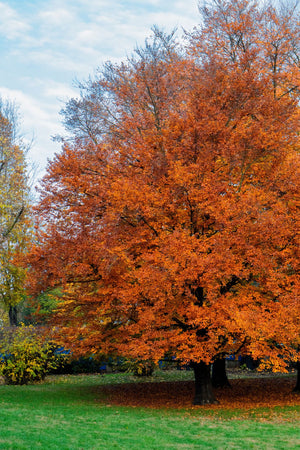
PLANTING
Maple trees are adaptable, but proper planting conditions will enhance their health and performance.
USDA Hardiness Zones: Most maples grow in Zones 3–9, depending on species. Japanese maples and sugar maples are hardy to Zone 5, while red maples and hybrids extend further south.
Soil: Maples prefer well-drained, slightly acidic to neutral soils rich in organic matter. Some species tolerate clay or compacted soil, especially Acer rubrum and Acer x freemanii.
Sunlight: Full sun to partial shade is ideal for most maples. Japanese maples and other ornamental types may prefer dappled shade to prevent leaf scorch in hotter climates.
Watering: Provide consistent watering during the establishment phase. Mature trees are generally drought-tolerant but benefit from supplemental water during prolonged dry spells.
Spacing: Large maples like Acer saccharum and Acer rubrum should be planted 30–40 feet apart. Compact species such as Acer ginnala or Acer griseum can be spaced closer at 15–25 feet.
Planting Time: Plant in early spring or fall when temperatures are cooler and rainfall is more consistent. Container-grown trees can be planted during the growing season with care.
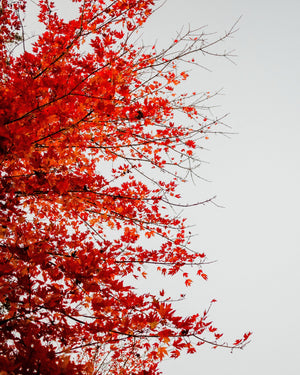
CARE
Watering: Deep watering is critical during the first 1–2 years. Mature trees benefit from watering during dry periods, especially in summer and early fall.
Fertilizing: Apply a slow-release, balanced fertilizer in spring if growth is weak or soil is poor. Avoid over-fertilizing, which can lead to excessive growth and weak wood.
Pruning: Prune maples in late winter to early spring before bud break, or in midsummer after full leaf-out to reduce bleeding. Remove crossing, dead, or crowded branches. Structural pruning is important for young trees to establish strong branching.
Pests and Diseases: Common issues include aphids, scale insects, tar spot, verticillium wilt, and anthracnose. Most are manageable with proper care and site selection. Maintain tree health through proper watering, mulching, and sanitation.
Mulching: Mulch 2–3 inches deep around the root zone to conserve moisture and regulate soil temperature. Keep mulch away from the trunk to avoid rot.
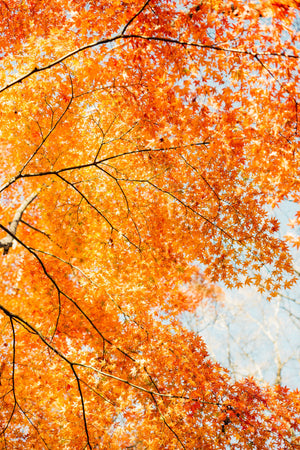
HOW TO USE
Focal Point: Maples make excellent focal point trees, especially cultivars with colorful fall foliage or striking bark. Use Acer griseum or Acer x pseudosieboldianum ‘Ice Dragon’ to draw the eye in a mixed border or courtyard.
Shade Trees: Large maples like Acer rubrum ‘Sun Valley’ or Acer saccharum ‘Legacy’ are ideal for providing summer shade on lawns, patios, or playgrounds.
Street and Urban Trees: Hardy cultivars like Acer rubrum ‘Frank Jr.’ or Acer x freemanii ‘Autumn Blaze’ offer strong branching and adaptability to urban pollution and compacted soils.
Small-Space Gardens: Compact species like Acer ginnala ‘Flame’ or Acer buergerianum ‘Miyasama yatsubusa’ fit well in urban yards or under power lines.
Ornamental and Asian-Inspired Gardens: Japanese and hybrid maples with fine texture and vibrant color are staples in serene, shaded settings. Pair with ferns, hostas, azaleas, or mosses.
Woodland Gardens: Native species like Acer saccharum and Acer circinatum integrate beautifully into naturalized or wooded spaces.
Fall Color Displays: Use maples with reliable autumn color as seasonal highlights. Pair with other fall standouts like Nyssa sylvatica, Fothergilla, or Amelanchier.
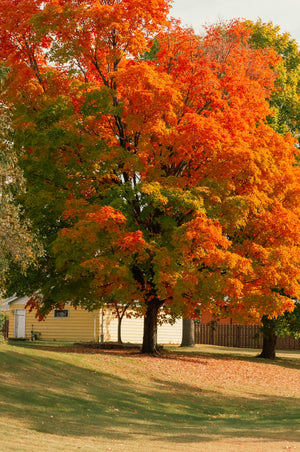
Common Questions
When to prune maple trees? Late winter or midsummer are ideal pruning times. Avoid early spring when sap is flowing heavily, as maples may "bleed."
What does a maple tree look like? Most maples have lobed, palmate leaves and rounded to upright forms. Some have peeling bark or striking foliage colors in spring and fall.
How fast do maple trees grow? Growth rates vary. Red maples and Freeman hybrids grow quickly (2–3 feet per year), while sugar maples and Japanese maples are slower-growing.
How long do maple trees live? Many maples live 80–150 years or more under good conditions. Slow-growing types like sugar maple may live the longest.
How tall do maple trees get? Large shade trees can reach 60–80 feet tall, while smaller ornamental types range from 10 to 25 feet.
Is a maple tree a hardwood? Yes, maple is a hardwood used for furniture, flooring, and musical instruments. Sugar maple wood is especially valued.
How to identify maple trees? Identification involves examining leaf shape, bark, branching pattern, and seed type. Most maples produce paired winged seeds called samaras.
Do maple trees need full sun? Most perform best in full sun. Some ornamental types like Japanese maples appreciate light shade, especially in hotter climates.
Which maple trees have the best fall color? Acer rubrum, Acer saccharum, and many Freeman hybrids offer vibrant red, orange, or yellow foliage. Cultivars like ‘Autumn Blaze’, ‘Brandywine’, and ‘Sun Valley’ are known for exceptional color.
Conclusion
Maples are among the most useful and beautiful trees for temperate landscapes, offering stunning seasonal changes, reliable structure, and options for nearly every setting. With their unmatched fall color, ease of care, and ecological value, maples remain an essential choice for homeowners, designers, and city planners alike.
The Maple Collection
Sold Out

